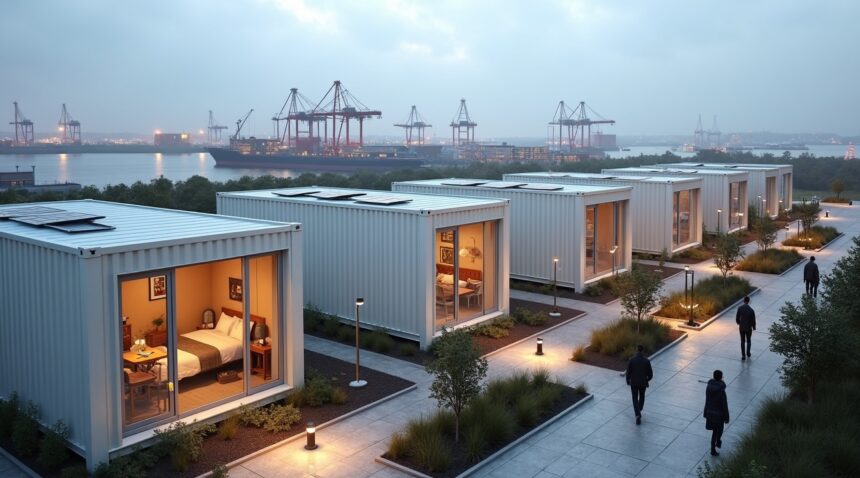Ireland’s shipping yard conversion initiative is redefining urban development by transforming underused industrial zones into state-of-the-art modular shelters, providing immediate housing solutions at unprecedented speeds during a time of surging property prices.
Key Takeaways
- Accelerated construction timelines – Factory-controlled production eliminates weather risks and facilitates 50-60% faster building completion than traditional construction methods.
- Complete self-sufficiency upon delivery – Each modular unit arrives fully outfitted with beds, electric stoves, toilets, and utility hookups, allowing for immediate habitation.
- Strategic land repurposing – By converting shipping yards, the initiative makes intelligent use of existing infrastructure and logistical access while revitalizing neglected industrial areas.
- Superior energy efficiency standards – These modern units surpass current Irish building codes through enhanced insulation, LED lighting, and energy-smart appliances.
- Flexible deployment capabilities – Units can be relocated, scaled, or reconfigured, adapting efficiently to varying community needs and emergency housing requirements.
The initiative is a noteworthy response to Ireland’s growing housing crisis, especially as property prices have reportedly risen 8.1%. Learn more about ongoing developments through this Irish Times article.
Shipping Yards Become Self-Contained Living Spaces with 50-60% Faster Build Times
Ireland’s approach to housing challenges has taken an innovative turn as the nation converts shipping yards into functional modular shelters. These units represent a complete departure from traditional construction methods, delivering fully equipped living spaces that arrive ready for immediate occupancy. Each shelter comes pre-fitted with essential amenities including beds, compact electric stoves, and individual toilets, eliminating the typical waiting periods associated with conventional housing setups.
Accelerated Construction Through Factory-Controlled Production
The manufacturing process behind these modular shelters produces remarkable time savings compared to standard building methods. Construction teams complete units 50-60% faster than conventional housing approaches by utilizing controlled factory environments that eliminate weather-related delays and seasonal construction limitations. This accelerated timeline addresses Ireland’s pressing housing demands while offering substantial cost reductions during a period when the Residential Property Price Index has surged 8.1% in the year leading to January 2025.
Factory-controlled assembly allows workers to maintain consistent production schedules regardless of external conditions. Teams can simultaneously work on multiple units while electrical, plumbing, and finishing components are installed in parallel rather than sequential phases. This efficiency translates directly into:
- Reduced labor costs
- Faster deployment of housing solutions
- Minimized environmental impact
The result is a highly efficient, repeatable construction process adaptable to a wide range of Ireland’s communities.
Complete Self-Sufficiency Upon Delivery
Each modular unit functions as a complete living environment from the moment it reaches its destination. The pre-installed amenities ensure residents can begin using their new accommodations immediately without additional setup requirements or extended waiting periods for utility connections. Compact electric stoves provide cooking capabilities while maintaining energy efficiency standards suitable for various power grid configurations.
The inclusion of individual toilets in each unit represents a significant advancement in temporary housing solutions, offering privacy and dignity that many emergency shelters lack. These facilities are designed to connect seamlessly with existing municipal water and sewage systems, reducing the infrastructure burden on host communities. The modular design also allows for:
- Easy expansion or downsizing
- Rapid relocation
- Flexible responses to changing housing demands
These shipping yard conversions offer Ireland a scalable response to both urgent housing needs and increased migration pressures. The combination of speed, cost-effectiveness, and immediate livability positions these modular shelters as a practical solution that bridges the gap between emergency accommodation and permanent housing development. Construction teams can deploy multiple units rapidly while maintaining quality standards that ensure long-term durability and resident comfort.
The controlled manufacturing environment also enables consistent quality control measures that are often challenging to maintain in traditional on-site construction. Each unit undergoes thorough testing and inspection before transport, reducing the likelihood of post-delivery issues that could delay occupancy. This reliability factor has become increasingly important as gaming communities and other groups seek stable housing solutions.
Transportation logistics have been streamlined to accommodate the modular design, with units sized to fit standard shipping containers and freight systems. This compatibility allows for efficient distribution across Ireland’s geography while maintaining the structural integrity of pre-installed components. The result is a housing solution that combines industrial efficiency with residential functionality, delivering homes that are both practical and immediately habitable.
https://www.youtube.com/watch?v=Mq5kfH1zHnI
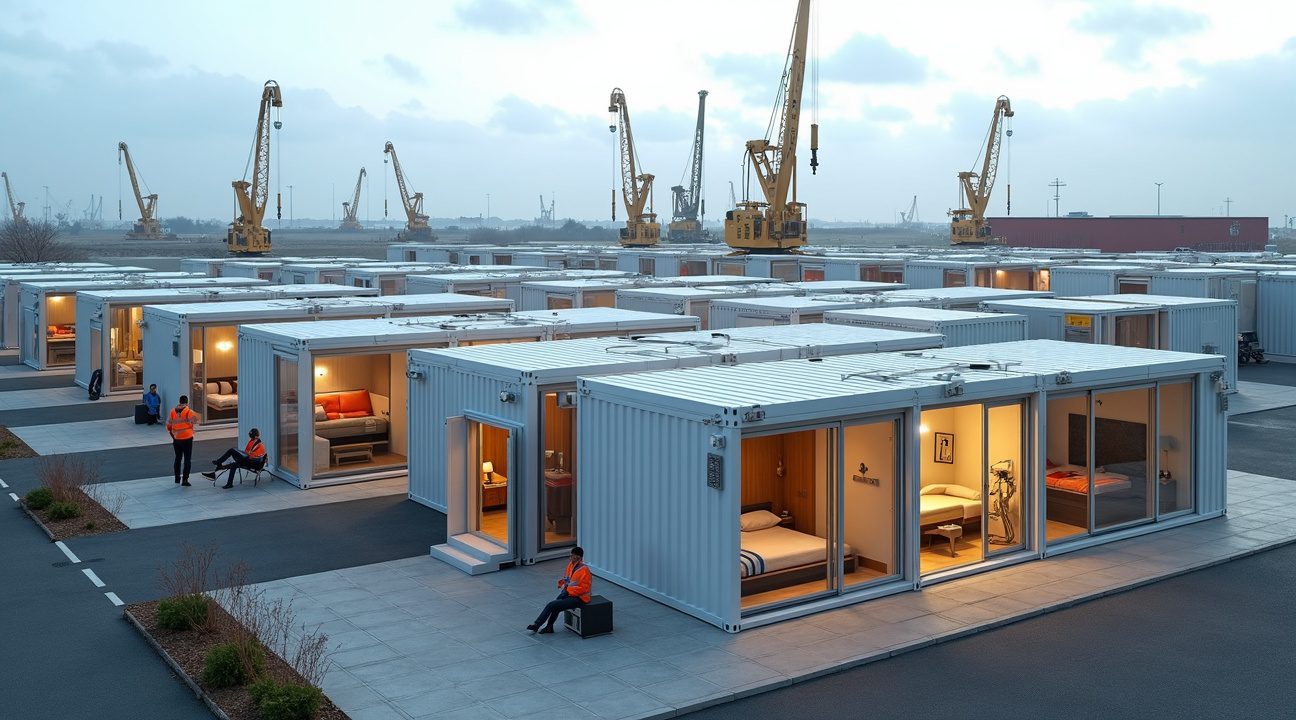
Repurposing Industrial Land Meets Ireland’s Housing Crisis Head-On
Ireland’s approach to converting shipping yards into modular shelters represents a strategic shift in addressing the country’s acute housing shortage. This innovative solution transforms previously under-utilized industrial spaces into vital residential areas, creating immediate housing options in high-demand urban locations where available land remains scarce.
Industrial sites offer unique advantages for rapid housing deployment. These areas typically possess existing infrastructure including utilities, transportation access, and zoning approval processes that can be expedited more easily than residential developments. By converting shipping yards specifically, Ireland leverages spaces that were already designed for modular construction and heavy equipment movement, making them ideal for prefabricated housing installation.
Speed and Efficiency Transform Emergency Housing Response
The modular approach delivers remarkable time advantages over traditional construction methods. While conventional housing projects often stretch across many months or even years, these pre-fitted units can be ready for occupancy within weeks of ordering. Each shelter arrives complete with essential amenities including beds, cooking stoves, and bathroom facilities, eliminating the typical delays associated with separate installations of fixtures and utilities.
This rapid deployment capability proves particularly valuable for addressing Ireland’s immediate housing needs. The modular units serve multiple purposes within the housing spectrum:
- Emergency accommodation for displaced populations
- Transitional housing for individuals and families between permanent residences
- Temporary solutions during major housing developments
- Crisis response shelters during natural disasters or emergencies
- Student housing during peak enrollment periods
Cost-effectiveness remains another compelling advantage of this industrial repurposing strategy. Traditional housing development requires extensive site preparation, foundation work, and lengthy construction phases that accumulate significant labor costs. Modular units manufactured off-site reduce these expenses while maintaining quality standards. The shipping yard locations also offer lower land acquisition costs compared to prime residential areas, allowing for more affordable housing solutions.
Ireland’s housing crisis demands innovative approaches that can scale quickly to meet growing demand. Population growth and migration patterns continue to strain existing housing stock, particularly in urban centers where employment opportunities concentrate. Much like how global phenomena can shift rapidly, housing needs require equally agile responses.
The success of converting shipping yards into residential spaces could establish a replicable model for other regions facing similar housing challenges. These industrial conversions demonstrate how creative land use can provide practical solutions without requiring entirely new infrastructure development. The modular shelter program addresses both immediate housing needs and long-term urban planning goals, creating flexible housing options that can adapt to changing demographic patterns and economic conditions.
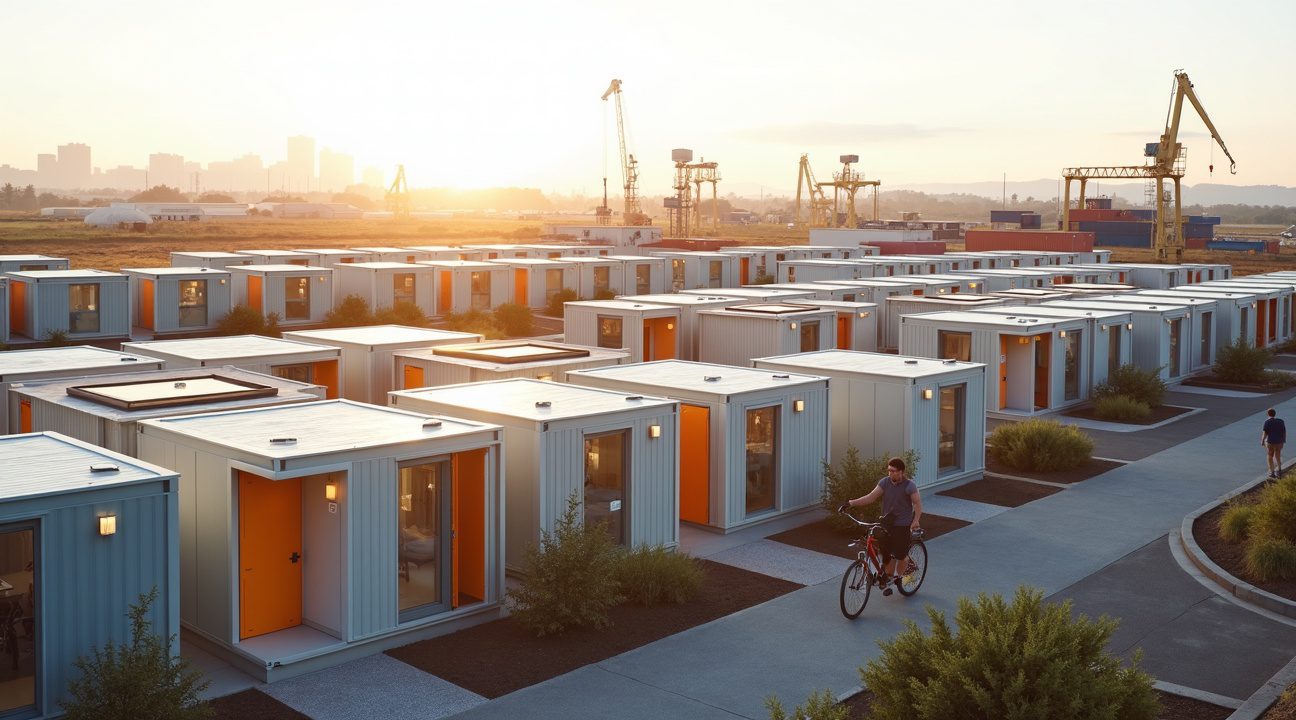
Modern Modular Units Exceed Ireland’s Building Standards with Energy Efficiency
I’ve observed a remarkable transformation in how Ireland approaches emergency housing through its innovative shipping yard conversions. These modern modular shelters represent a significant leap forward from the basic prefabricated units that dominated emergency housing solutions just a decade ago.
Advanced Engineering Meets Environmental Responsibility
Today’s modular units incorporate cutting-edge engineering principles that prioritize both occupant comfort and environmental stewardship. Each shelter features high-performance insulation systems that maintain consistent interior temperatures while minimizing energy consumption. The controlled factory environment allows manufacturers to install low-energy appliances with precision, ensuring optimal performance from day one.
Factory-based construction brings substantial environmental benefits that traditional building methods simply can’t match. Construction waste reduction reaches up to 40% compared to conventional building approaches, primarily because manufacturers can optimize material usage and recycle excess components immediately. This controlled environment also eliminates weather-related delays that often lead to material waste on traditional construction sites.
Exceeding National Standards Through Innovation
Ireland’s building regulations set comprehensive standards for thermal performance, ventilation, and energy efficiency. Modern modular shelters don’t just meet these requirements – they consistently surpass them. Advanced insulation materials and airtight construction techniques create thermal envelopes that exceed minimum R-value requirements by significant margins.
The integration of energy-efficient systems extends beyond basic heating and cooling. These units incorporate:
- LED lighting systems
- High-efficiency water heaters
- Smart ventilation controls that automatically adjust based on occupancy levels
Such features align perfectly with Ireland’s national objectives for sustainable development while providing residents with comfortable, cost-effective living spaces.
Manufacturing quality control plays a crucial role in achieving these superior performance standards. Factory conditions allow for precise installation of building components without exposure to moisture, temperature fluctuations, or other environmental factors that can compromise performance in traditional construction. Each unit undergoes rigorous testing before leaving the facility, ensuring consistent quality across all installations.
The sustainable nature of this construction approach supports Ireland’s broader environmental goals while addressing immediate housing needs. Modular construction typically requires 50% less energy during the building process compared to traditional methods. Additionally, the ability to relocate and repurpose these units extends their useful life far beyond that of conventional temporary housing solutions.
These advancements reflect a fundamental shift in how emergency housing addresses both immediate humanitarian needs and long-term environmental responsibility. The shipping yard conversion program demonstrates that crisis response doesn’t require compromising on quality or sustainability standards. Instead, it showcases how innovation can deliver superior outcomes while maintaining the speed and efficiency essential for emergency housing deployment.
Modern modular shelters also incorporate renewable energy readiness, with pre-installed electrical systems designed to accommodate solar panels and other green energy solutions. This forward-thinking approach ensures that units can adapt to evolving energy technologies and changing environmental regulations without requiring extensive modifications.
The economic benefits of exceeding building standards become apparent over time through reduced operational costs. Superior insulation and energy-efficient appliances translate directly into lower utility bills for residents, while the reduced maintenance requirements of factory-built components minimize long-term ownership costs. These factors make the modular approach not just environmentally responsible but financially sustainable for long-term implementation.
Quality construction materials selected for durability and performance contribute to the units’ ability to exceed standard requirements. Manufacturers choose components based on their proven track record in similar climates, ensuring that each shelter maintains its performance characteristics throughout extended use periods.

Flexible Shelter Solutions Can Be Reconfigured and Relocated as Needs Change
I find the modular nature of these converted shipping yard units to be their greatest strength. These pre-fitted shelters offer unmatched adaptability compared to conventional housing solutions. Each unit comes fully equipped with essential amenities including beds, stoves, and toilets, making them immediately liveable upon deployment.
The true power of this system lies in its responsiveness to changing circumstances. Communities can expand shelter clusters quickly when new populations arrive or relocate entire units to areas experiencing sudden demand spikes. This adaptability proves crucial during emergency situations where traditional housing solutions would take months or years to develop.
Key Flexibility Features
The modular design enables several adaptive responses:
- Units can be connected to create larger living spaces for families
- Individual shelters can be transported to different locations via standard freight methods
- Clusters can be downsized when demand decreases, freeing units for deployment elsewhere
- Interior configurations can be modified to accommodate different family sizes or special needs
- Utility connections allow for quick setup in new locations with minimal infrastructure requirements
Migration patterns across Ireland shift constantly, and these modular shelters respond to those changes in ways that permanent structures simply cannot. When one area experiences reduced demand, units can be relocated rather than sitting empty. This efficiency maximizes the utility of each shelter while minimizing waste.
Emergency housing needs don’t follow predictable schedules. Natural disasters, economic shifts, or sudden population movements can create urgent housing shortages in unexpected locations. Traditional construction timelines make it nearly impossible to respond quickly to such crises. These repurposed shipping yard units, however, can be deployed within days rather than months.
The economic benefits of this flexibility extend beyond immediate cost savings. Ireland avoids the sunk costs associated with permanent structures that may outlive their usefulness in specific locations. Instead, the investment travels with the need, maintaining its value regardless of changing demographics or housing demands.
Each unit’s standardized design ensures compatibility with existing clusters while maintaining individual functionality. This consistency allows housing authorities to mix and match units from different deployments without compatibility issues. The result is a housing system that grows and contracts organically based on actual need rather than projected demand.
The shipping yard conversion process creates durable structures that withstand repeated relocations without compromising their integrity. Unlike temporary housing solutions that deteriorate with movement, these units maintain their quality and functionality through multiple deployments. This durability makes them a sustainable long-term solution rather than a short-term fix.
Innovative approaches to housing challenges often emerge from unexpected sources, and Ireland’s modular shelter program exemplifies this principle.
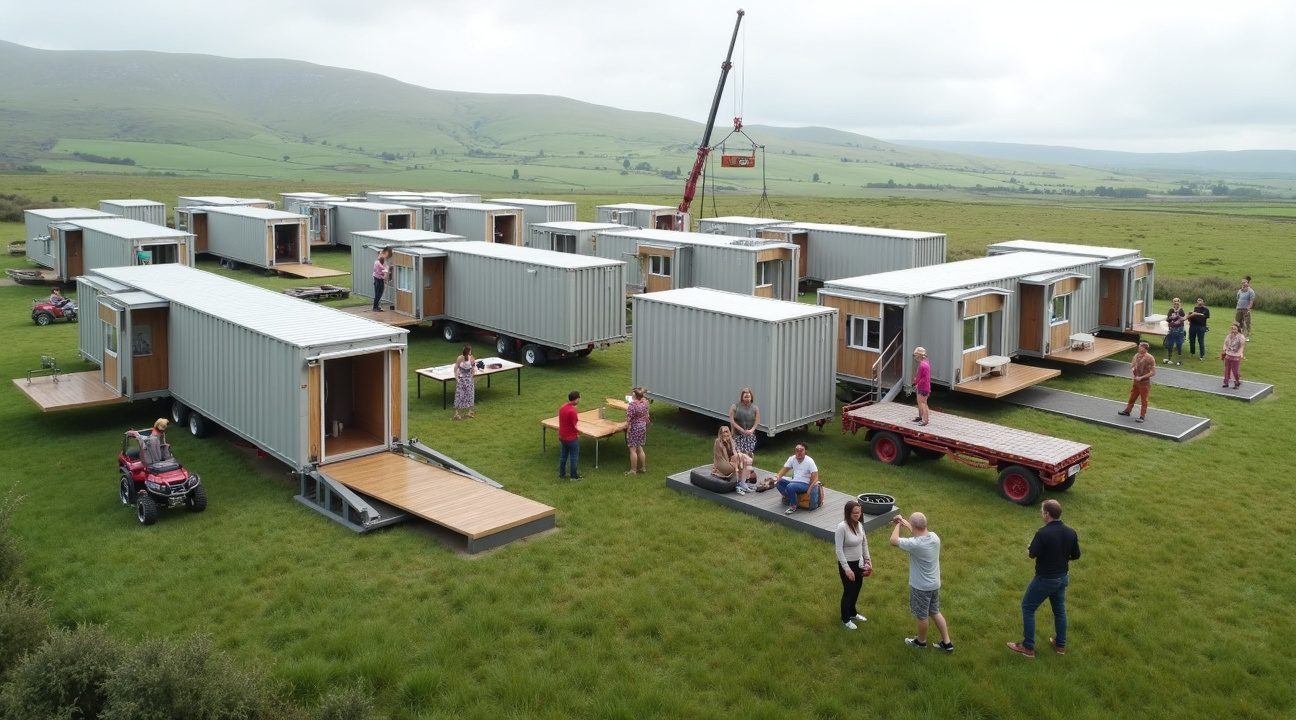
Government and Industry Support Drives Modular Innovation Forward
Irish government backing has become a cornerstone in accelerating modular construction adoption across the country. The administration recognizes modular building as a critical solution for addressing housing shortages and emergency accommodation needs, particularly as traditional construction methods struggle to keep pace with demand.
Strategic Framework and Industry Standards
The Modular Building Institute (MBI) leads efforts to establish comprehensive standards that ensure quality and safety in modular construction projects. These guidelines create a foundation for manufacturers to develop reliable, standardized units that can be efficiently deployed across various locations. Industry partnerships between local Irish companies and international experts have strengthened technical capabilities, allowing for knowledge transfer and innovation sharing.
Key developments include:
- Standardized design protocols
- Quality assurance measures
- Streamlined approval processes
These advances enable faster project delivery while maintaining construction integrity. The collaborative approach has attracted significant investment from both domestic and foreign entities, creating a competitive market that drives down costs and improves efficiency.
The Programme for Government 2025 specifically allocates resources for modular and innovative construction strategies, acknowledging their importance in meeting Ireland’s evolving housing needs. This policy framework provides financial incentives for companies investing in modular technology and establishes fast-track planning permissions for approved modular developments.
Industry response has been overwhelmingly positive, with manufacturers expanding production capabilities and developing specialized units for different applications. Construction companies are investing in training programs to build expertise in modular assembly and installation techniques. This skilled workforce development ensures projects can be completed quickly and to high standards.
Financial institutions have also adapted their lending practices to accommodate modular construction projects, recognizing their viability and reduced construction timelines. This banking support makes projects more accessible to developers and housing associations seeking rapid deployment solutions.
The government’s commitment extends beyond policy formation to active participation in pilot programs that demonstrate modular construction effectiveness. These showcase projects serve as testing grounds for new technologies and approaches while building public confidence in modular solutions. Success stories from these initiatives have encouraged wider adoption across public and private sectors.
International cooperation agreements have brought cutting-edge manufacturing techniques to Ireland, positioning the country as a regional hub for modular innovation. These partnerships facilitate technology transfer and create export opportunities for Irish-manufactured units.
Quality control measures implemented through government oversight ensure all modular units meet strict safety and habitability standards. Regular inspections and certification processes maintain public trust while protecting residents’ welfare. Just as entertainment industries have seen collaborative innovations, Ireland’s construction sector benefits from strategic partnerships that blend expertise and resources effectively.
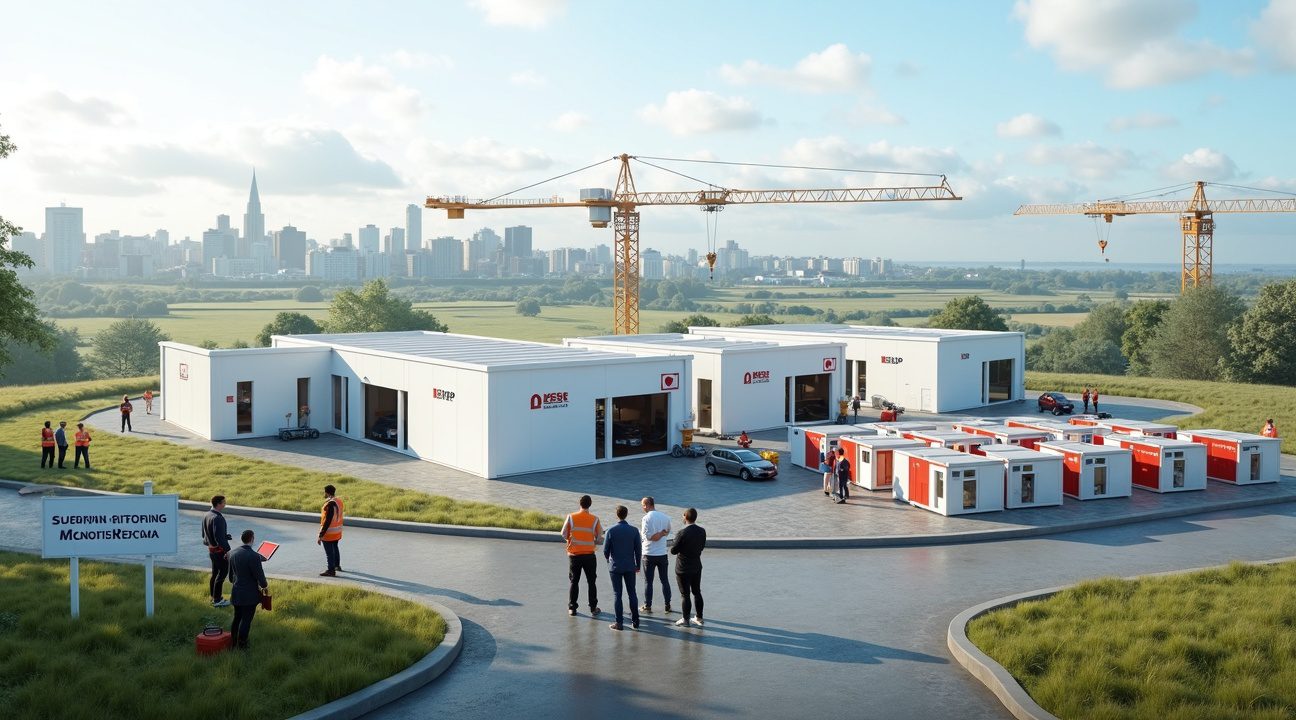
Modular Construction Expands Beyond Emergency Shelter to Transform Ireland’s Infrastructure
Ireland’s journey from converting shipping yards into emergency shelters has sparked a broader transformation across the nation’s infrastructure landscape. What began as an urgent response to housing crises has evolved into a comprehensive strategy that’s reshaping how I view construction across multiple sectors.
The success of modular emergency accommodations has proven the viability of prefabricated solutions, leading to their adoption in educational facilities, healthcare centers, and permanent residential developments. Schools across Ireland are now incorporating modular classrooms that can be assembled in weeks rather than months, providing flexible solutions for growing student populations. Healthcare facilities benefit from modular construction’s ability to create sterile, controlled environments quickly, particularly valuable during health emergencies or when expanding existing hospitals.
Industry Growth and Innovation Drive Sector Expansion
The modular construction industry in Ireland has experienced unprecedented growth, with manufacturers investing heavily in advanced fabrication technologies and sustainable materials. Companies are developing sophisticated modules that integrate smart building systems, renewable energy sources, and high-performance insulation that exceeds traditional construction standards.
Key developments driving this expansion include:
- Advanced manufacturing facilities that produce modules with precision-engineered components
- Integration of Building Information Modeling (BIM) technology for improved design accuracy
- Development of hybrid construction methods combining modular and traditional techniques
- Investment in sustainable materials and carbon-neutral manufacturing processes
- Creation of specialized modules for specific sectors like healthcare and education
Industry events like World of Modular Europe 2025 highlight the sector’s momentum, bringing together manufacturers, architects, and policymakers to showcase innovations that extend far beyond basic emergency shelter. These gatherings demonstrate how technology innovations are pushing modular construction into new territories, from luxury residential developments to specialized industrial applications.
The infrastructure modernization effort encompasses not just housing but critical public services. Modular police stations, fire departments, and community centers are being deployed across rural areas where traditional construction would be prohibitively expensive or time-consuming. Government agencies are recognizing that modular solutions can deliver essential services to underserved communities faster than conventional methods.
Technology integration has become a cornerstone of modern modular construction in Ireland. Smart modules arrive pre-wired with IoT sensors, energy management systems, and connectivity infrastructure. This advancement allows buildings to monitor their own performance, optimize energy consumption, and provide real-time data on occupancy and maintenance needs.
The shift from emergency response to permanent infrastructure reflects changing attitudes about prefabricated construction quality. Modern Irish modules feature architectural designs that rival traditional buildings, incorporating local materials and design elements that blend seamlessly with existing neighborhoods. Developers are creating modular apartment complexes, office buildings, and mixed-use developments that challenge preconceptions about factory-built structures.
Manufacturing capabilities have expanded dramatically, with Irish companies now producing modules for export to other European markets. This growth has created a skilled workforce specializing in precision manufacturing, quality control, and advanced assembly techniques. The sector’s evolution from emergency housing to comprehensive infrastructure solutions demonstrates how crisis-driven innovation can catalyze broader economic development.
Quality standards for modular construction now exceed many traditional building requirements, with rigorous testing protocols ensuring structural integrity, fire safety, and energy efficiency. Certification processes have evolved to accommodate the unique characteristics of modular construction while maintaining the highest safety and performance standards.
The economic impact extends beyond construction itself, creating supply chain opportunities for Irish manufacturers of windows, fixtures, appliances, and building materials. Local suppliers are adapting their products specifically for modular applications, fostering innovation throughout the construction ecosystem.
Future developments point toward even greater integration of modular methods in Ireland’s infrastructure strategy. Government planning policies increasingly favor construction methods that reduce environmental impact, accelerate project timelines, and provide flexible solutions for changing community needs. This policy support ensures that modular construction will continue expanding beyond its emergency shelter origins to become a fundamental component of Ireland’s built environment.

Sources:
The Pod Factory – “Modular Homes in Ireland 2025: The Smarter Way to Build”
Modular Building Institute – “Ireland’s Expanding Modular Construction Industry with MBI”
Government of Ireland – “Draft Programme for Government 2025”

